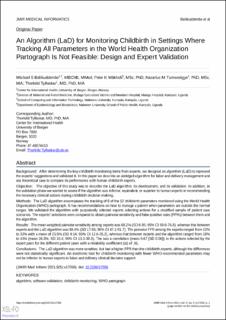| dc.contributor.author | Balikuddembe, Michael | |
| dc.contributor.author | Wakholi, Peter Khisa | |
| dc.contributor.author | Tumwesigye, Nazarius M. | |
| dc.contributor.author | Tylleskär, Thorkild | |
| dc.date.accessioned | 2022-03-25T12:11:38Z | |
| dc.date.available | 2022-03-25T12:11:38Z | |
| dc.date.created | 2022-01-24T14:41:15Z | |
| dc.date.issued | 2021 | |
| dc.identifier.issn | 2291-9694 | |
| dc.identifier.uri | https://hdl.handle.net/11250/2987641 | |
| dc.description.abstract | Background:
After determining the key childbirth monitoring items from experts, we designed an algorithm (LaD) to represent the experts’ suggestions and validated it. In this paper we describe an abridged algorithm for labor and delivery management and use theoretical case to compare its performance with human childbirth experts.
Objective:
The objective of this study was to describe the LaD algorithm, its development, and its validation. In addition, in the validation phase we wanted to assess if the algorithm was inferior, equivalent, or superior to human experts in recommending the necessary clinical actions during childbirth decision making.
Methods:
The LaD algorithm encompasses the tracking of 6 of the 12 childbirth parameters monitored using the World Health Organization (WHO) partograph. It has recommendations on how to manage a patient when parameters are outside the normal ranges. We validated the algorithm with purposively selected experts selecting actions for a stratified sample of patient case scenarios. The experts’ selections were compared to obtain pairwise sensitivity and false-positive rates (FPRs) between them and the algorithm.
Results:
The mean weighted pairwise sensitivity among experts was 68.2% (SD 6.95; 95% CI 59.6-76.8), whereas that between experts and the LaD algorithm was 69.4% (SD 17.95; 95% CI 47.1-91.7). The pairwise FPR among the experts ranged from 12% to 33% with a mean of 23.9% (SD 9.14; 95% CI 12.6-35.2), whereas that between experts and the algorithm ranged from 18% to 43% (mean 26.3%; SD 10.4; 95% CI 13.3-39.3). The was a correlation (mean 0.67 [SD 0.06]) in the actions selected by the expert pairs for the different patient cases with a reliability coefficient (α) of .91.
Conclusions:
The LaD algorithm was more sensitive, but had a higher FPR than the childbirth experts, although the differences were not statistically significant. An electronic tool for childbirth monitoring with fewer WHO-recommended parameters may not be inferior to human experts in labor and delivery clinical decision support. | en_US |
| dc.language.iso | eng | en_US |
| dc.publisher | JMIR | en_US |
| dc.rights | Navngivelse 4.0 Internasjonal | * |
| dc.rights.uri | http://creativecommons.org/licenses/by/4.0/deed.no | * |
| dc.title | An Algorithm (LaD) for Monitoring Childbirth in Settings Where Tracking All Parameters in the World Health Organization Partograph Is Not Feasible: Design and Expert Validation | en_US |
| dc.type | Journal article | en_US |
| dc.type | Peer reviewed | en_US |
| dc.description.version | publishedVersion | en_US |
| dc.rights.holder | Copyright 2021 The Author(s) | en_US |
| dc.source.articlenumber | e17056 | en_US |
| cristin.ispublished | true | |
| cristin.fulltext | original | |
| cristin.qualitycode | 1 | |
| dc.identifier.doi | 10.2196/17056 | |
| dc.identifier.cristin | 1988706 | |
| dc.source.journal | JMIR Medical Informatics | en_US |
| dc.identifier.citation | JMIR Medical Informatics. 2021, 9 (5), e17056. | en_US |
| dc.source.volume | 9 | en_US |
| dc.source.issue | 5 | en_US |

